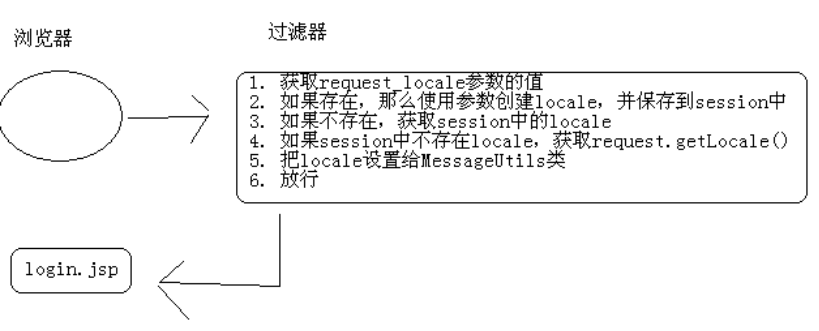JavaWeb监听器
三大组件:
l Servlet
l Listener
l Filter
Listener:监听器
1. 初次相见:AWT
2. 二次相见:SAX
监听器:
l 它是一个接口,内容由我们来实现;
l 它需要注册,例如注册在按钮上!
l 监听器中的方法,会在特殊事件发生时被调用!
观察者:
l 事件源;
Ø 小偷
l 事件;
Ø 偷东西
l 监听器;
Ø 警察
Ø 监听器中的方法:抓捕
JavaWeb中的监听器
l 事件源:三大域!
Ø ServletContext
¨ 生命周期监听:ServletContextListener,它有两个方法,一个在出生时调用,一个在死亡时调用;
² void contextInitialized(ServletContextEvent sce):创建SErvletcontext时
² void contextDestroyed(ServletContextEvent sce):销毁Servletcontext时
¨ 属性监听:ServletContextAttributeListener,它有三个方法,一个在添加属性时调用,一个在替换属性时调用,最后一个是在移除属性时调用。
² void attributeAdded(ServletContextAttributeEvent event):添加属性时;
² void attributeReplaced(ServletContextAttributeEvent event):替换属性时;
² void attributeRemoved(ServletContextAttributeEvent event):移除属性时;
Ø HttpSession
¨ 生命周期监听:HttpSessionListener,它有两个方法,一个在出生时调用,一个在死亡时调用;
² void sessionCreated(HttpSessionEvent se):创建session时
² void sessionDestroyed(HttpSessionEvent se):销毁session时
¨ 属性监听:HttpSessioniAttributeListener,它有三个方法,一个在添加属性时调用,一个在替换属性时调用,最后一个是在移除属性时调用。
² void attributeAdded(HttpSessionBindingEvent event):添加属性时;
² void attributeReplaced(HttpSessionBindingEvent event):替换属性时
² void attributeRemoved(HttpSessionBindingEvent event):移除属性时
Ø ServletRequest
¨ 生命周期监听:ServletRequestListener,它有两个方法,一个在出生时调用,一个在死亡时调用;
² void requestInitialized(ServletRequestEvent sre):创建request时
² void requestDestroyed(ServletRequestEvent sre):销毁request时
¨ 属性监听:ServletRequestAttributeListener,它有三个方法,一个在添加属性时调用,一个在替换属性时调用,最后一个是在移除属性时调用。
² void attributeAdded(ServletRequestAttributeEvent srae):添加属性时
² void attributeReplaced(ServletRequestAttributeEvent srae):替换属性时
² void attributeRemoved(ServletRequestAttributeEvent srae):移除属性时
l javaWeb中完成编写监听器:
Ø 写一个监听器类:要求必须去实现某个监听器接口;
Ø 注册,是在web.xml中配置来完成注册!
l 事件对象:
Ø ServletContextEvent:ServletContext getServletContext()
Ø HttpSessionEvent:HttpSession getSession()
Ø ServletRequest:
¨ ServletContext getServletContext();
¨ ServletReques getServletRequest();
Ø ServletContextAttributeEvent:
¨ ServletContext getServletContext();
¨ String getName():获取属性名
¨ Object getValue():获取属性值
Ø ServletRequestAttributeEvent :略
感知监听(都与HttpSession相关)
l 它用来添加到JavaBean上,而不是添加到三大域上!
l 这两个监听器都不需要在web.xml中注册!
HttpSessionBindingListener:添加到javabean上,javabean就知道自己是否添加到session中了。
1 JavaWeb监听器概述
在JavaWeb被监听的事件源为:ServletContext、HttpSession、ServletRequest,即三大域对象。
l 监听域对象“创建”与“销毁”的监听器;
l 监听域对象“操作域属性”的监听器;
l 监听HttpSession的监听器。
2 创建与销毁监听器
创建与销毁监听器一共有三个:
l ServletContextListener:Tomcat启动和关闭时调用下面两个方法
Ø public void contextInitialized(ServletContextEvent evt):ServletContext对象被创建后调用;
Ø public void contextDestroyed(ServletContextEvent evt):ServletContext对象被销毁前调用;
l HttpSessionListener:开始会话和结束会话时调用下面两个方法
Ø public void sessionCreated(HttpSessionEvent evt):HttpSession对象被创建后调用;
Ø public void sessionDestroyed(HttpSessionEvent evt):HttpSession对象被销毁前调用;
l ServletRequestListener:开始请求和结束请求时调用下面两个方法
Ø public void requestInitiallized(ServletRequestEvent evt):ServletRequest对象被创建后调用;
Ø public void requestDestroyed(ServletRequestEvent evt):ServletRequest对象被销毁前调用。
事件对象
l ServletContextEvent:ServletContext getServletContext();
l HttpSeessionEvent:HttpSession getSession();
l ServletRequestEvent:
Ø ServletRequest getServletRequest()
Ø ServletContext getServletContext()
编写测试例子:
l 编写MyServletContextListener类,实现ServletContextListener接口;
l 在web.xml文件中部署监听器;
l 为了看到session销毁的效果,在web.xml文件中设置session失效时间为1分钟;
|
/* * ServletContextListener实现类 * contextDestroyed() -- 在ServletContext对象被销毁前调用 * contextInitialized() -- -- 在ServletContext对象被创建后调用 * ServletContextEvent -- 事件类对象 * 该类有getServletContext(),用来获取ServletContext对象,即获取事件源对象 */ public class MyServletContextListener implements ServletContextListener { public void contextDestroyed(ServletContextEvent evt) { System.out.println("销毁ServletContext对象"); }
public void contextInitialized(ServletContextEvent evt) { System.out.println("创建ServletContext对象"); } } |
|
/* * HttpSessionListener实现类 * sessionCreated() -- 在HttpSession对象被创建后被调用 * sessionDestroyed() -- -- 在HttpSession对象被销毁前调用 * HttpSessionEvent -- 事件类对象 * 该类有getSession(),用来获取当前HttpSession对象,即获取事件源对象 */ public class MyHttpSessionListener implements HttpSessionListener { public void sessionCreated(HttpSessionEvent evt) { System.out.println("创建session对象"); }
public void sessionDestroyed(HttpSessionEvent evt) { System.out.println("销毁session对象"); } }
|
|
/* * ServletRequestListener实现类 * requestDestroyed() -- 在ServletRequest对象被销毁前调用 * requestInitialized() -- 在ServletRequest对象被创建后调用 * ServletRequestEvent -- 事件类对象 * 该类有getServletContext(),用来获取ServletContext对象 * 该类有getServletRequest(),用来获取当前ServletRequest对象,即事件源对象 */ public class MyServletRequestListener implements ServletRequestListener { public void requestDestroyed(ServletRequestEvent evt) { System.out.println("销毁request对象"); }
public void requestInitialized(ServletRequestEvent evt) { System.out.println("创建request对象"); } }
|
|
<listener> <listener-class>cn.itcast.listener.MyServletContextListener</listener-class> </listener> <listener> <listener-class>cn.itcast.listener.MyHttpSessionListener</listener-class> </listener> <listener> <listener-class>cn.itcast.listener.MyServletRequestListener</listener-class> </listener> <session-config> <session-timeout>1</session-timeout> </session-config> |
3 操作域属性的监听器
当对域属性进行增、删、改时,执行的监听器一共有三个:
l ServletContextAttributeListener:在ServletContext域进行增、删、改属性时调用下面方法。
Ø public void attributeAdded(ServletContextAttributeEvent evt)
Ø public void attributeRemoved(ServletContextAttributeEvent evt)
Ø public void attributeReplaced(ServletContextAttributeEvent evt)
l HttpSessionAttributeListener:在HttpSession域进行增、删、改属性时调用下面方法
Ø public void attributeAdded(HttpSessionBindingEvent evt)
Ø public void attributeRemoved (HttpSessionBindingEvent evt)
Ø public void attributeReplaced (HttpSessionBindingEvent evt)
l ServletRequestAttributeListener:在ServletRequest域进行增、删、改属性时调用下面方法
Ø public void attributeAdded(ServletRequestAttributeEvent evt)
Ø public void attributeRemoved (ServletRequestAttributeEvent evt)
Ø public void attributeReplaced (ServletRequestAttributeEvent evt)
下面对这三个监听器的事件对象功能进行介绍:
l ServletContextAttributeEvent
Ø String getName():获取当前操作的属性名;
Ø Object getValue():获取当前操作的属性值;
Ø ServletContext getServletContext():获取ServletContext对象。
l HttpSessionBindingEvent
Ø String getName():获取当前操作的属性名;
Ø Object getValue():获取当前操作的属性值;
Ø HttpSession getSession():获取当前操作的session对象。
l ServletRequestAttributeEvent
Ø String getName():获取当前操作的属性名;
Ø Object getValue():获取当前操作的属性值;
Ø ServletContext getServletContext():获取ServletContext对象;
Ø ServletRequest getServletRequest():获取当前操作的ServletRequest对象。
|
public class MyListener implements ServletContextAttributeListener,ServletRequestAttributeListener, HttpSessionAttributeListener { public void attributeAdded(HttpSessionBindingEvent evt) { System.out.println("向session中添加属性:" + evt.getName() + "=" + evt.getValue()); }
public void attributeRemoved(HttpSessionBindingEvent evt) { System.out.println("从session中移除属性:" + evt.getName() + "=" + evt.getValue()); }
public void attributeReplaced(HttpSessionBindingEvent evt) { System.out.println("修改session中的属性:" + evt.getName() + "=" + evt.getValue()); }
public void attributeAdded(ServletRequestAttributeEvent evt) { System.out.println("向request中添加属性:" + evt.getName() + "=" + evt.getValue()); }
public void attributeRemoved(ServletRequestAttributeEvent evt) { System.out.println("从request中移除属性:" + evt.getName() + "=" + evt.getValue()); }
public void attributeReplaced(ServletRequestAttributeEvent evt) { System.out.println("修改request中的属性:" + evt.getName() + "=" + evt.getValue()); }
public void attributeAdded(ServletContextAttributeEvent evt) { System.out.println("向context中添加属性:" + evt.getName() + "=" + evt.getValue()); }
public void attributeRemoved(ServletContextAttributeEvent evt) { System.out.println("从context中移除属性:" + evt.getName() + "=" + evt.getValue()); }
public void attributeReplaced(ServletContextAttributeEvent evt) { System.out.println("修改context中的属性:" + evt.getName() + "=" + evt.getValue()); } } |
|
public class ListenerServlet extends BaseServlet { public String contextOperation(HttpServletRequest request, HttpServletResponse response)throws ServletException, IOException { ServletContext context = this.getServletContext(); context.setAttribute("a", "a"); context.setAttribute("a", "A"); context.removeAttribute("a"); return "/index.jsp"; } /////////////////////////////// public String sessionOperation(HttpServletRequest request, HttpServletResponse response)throws ServletException, IOException { HttpSession session = request.getSession(); session.setAttribute("a", "a"); session.setAttribute("a", "A"); session.removeAttribute("a"); return "/index.jsp"; } ////////////////////////////// public String requestOperation(HttpServletRequest request, HttpServletResponse response)throws ServletException, IOException { request.setAttribute("a", "a"); request.setAttribute("a", "A"); request.removeAttribute("a"); return "/index.jsp"; } } |
|
<body> <a href="<c:url value='/ListenerServlet?method=contextOperation'/>">SevletContext操作属性</a> <br/> <a href="<c:url value='/ListenerServlet?method=sessionOperation'/>">HttpSession操作属性</a> <br/> <a href="<c:url value='/ListenerServlet?method=requestOperation'/>">ServletRequest操作属性</a> | </body> |
4 HttpSession的监听器
还有两个与HttpSession相关的特殊的监听器,这两个监听器的特点如下:
l 不用在web.xml文件中部署;
l 这两个监听器不是给session添加,而是给Bean添加。即让Bean类实现监听器接口,然后再把Bean对象添加到session域中。
下面对这两个监听器介绍一下:
l HttpSessionBindingListener:当某个类实现了该接口后,可以感知本类对象添加到session中,以及感知从session中移除。例如让Person类实现HttpSessionBindingListener接口,那么当把Person对象添加到session中,或者把Person对象从session中移除时会调用下面两个方法:
Ø public void valueBound(HttpSessionBindingEvent event):当把监听器对象添加到session中会调用监听器对象的本方法;
Ø public void valueUnbound(HttpSessionBindingEvent event):当把监听器对象从session中移除时会调用监听器对象的本方法;
这里要注意,HttpSessionBindingListener监听器的使用与前面介绍的都不相同,当该监听器对象添加到session中,或把该监听器对象从session移除时会调用监听器中的方法。并且无需在web.xml文件中部署这个监听器。
示例步骤:
l 编写Person类,让其实现HttpSessionBindingListener监听器接口;
l 编写Servlet类,一个方法向session中添加Person对象,另一个从session中移除Person对象;
l 在index.jsp中给出两个超链接,分别访问Servlet中的两个方法。
Pseron.java
|
public class Person implements HttpSessionBindingListener { private String name; private int age; private String sex;
public Person(String name, int age, String sex) { super(); this.name = name; this.age = age; this.sex = sex; } public Person() { super(); } public String toString() { return "Person [name=" + name + ", age=" + age + ", sex=" + sex + "]"; }
public String getName() { return name; }
public void setName(String name) { this.name = name; }
public int getAge() { return age; }
public void setAge(int age) { this.age = age; }
public String getSex() { return sex; }
public void setSex(String sex) { this.sex = sex; }
public void valueBound(HttpSessionBindingEvent evt) { System.out.println("把Person对象存放到session中:" + evt.getValue()); }
public void valueUnbound(HttpSessionBindingEvent evt) { System.out.println("从session中移除Pseron对象:" + evt.getValue()); } } |
ListenerServlet.java
|
public class ListenerServlet extends BaseServlet { public String addPerson(HttpServletRequest request, HttpServletResponse response)throws ServletException, IOException { Person p = new Person("zhangSan", 23, "male"); request.getSession().setAttribute("person", p); return "/index.jsp"; }
public String removePerson(HttpServletRequest request, HttpServletResponse response)throws ServletException, IOException { request.getSession().removeAttribute("person"); return "/index.jsp"; } |
index.jsp
|
<body> <a href="<c:url value='/ListenerServlet?method=addPerson'/>">addPerson</a> <br/> <a href="<c:url value='/ListenerServlet?method=removePerson'/>">removePerson</a> <br/> </body> |
l HttpSessionActivationListener:Tomcat会在session从时间不被使用时钝化session对象,所谓钝化session,就是把session通过序列化的方式保存到硬盘文件中。当用户再使用session时,Tomcat还会把钝化的对象再活化session,所谓活化就是把硬盘文件中的session在反序列化回内存。当session被Tomcat钝化时,session中存储的对象也被纯化,当session被活化时,也会把session中存储的对象活化。如果某个类实现了HttpSessionActiveationListener接口后,当对象随着session被钝化和活化时,下面两个方法就会被调用:
Ø public void sessionWillPassivate(HttpSessionEvent se):当对象感知被活化时调用本方法;
Ø public void sessionDidActivate(HttpSessionEvent se):当对象感知被钝化时调用本方法;
HttpSessionActivationListener监听器与HttpSessionBindingListener监听器相似,都是感知型的监听器,例如让Person类实现了HttpSessionActivationListener监听器接口,并把Person对象添加到了session中后,当Tomcat钝化session时,同时也会钝化session中的Person对象,这时Person对象就会感知到自己被钝化了,其实就是调用Person对象的sessionWillPassivate()方法。当用户再次使用session时,Tomcat会活化session,这时Person会感知到自己被活化,其实就是调用Person对象的sessionDidActivate()方法。
注意,因为钝化和活化session,其实就是使用序列化和反序列化技术把session从内存保存到硬盘,和把session从硬盘加载到内存。这说明如果Person类没有实现Serializable接口,那么当session钝化时就不会钝化Person,而是把Person从session中移除再钝化!这也说明session活化后,session中就不在有Person对象了。
示例步骤:
l 先不管HttpSessionActivationListener监听器接口,先来配置Tomcat钝化session的参数,把下面配置文件放到tomcat\conf\catalina\localhost目录下!文件名称为项目名称。
|
<Context> <Manager className="org.apache.catalina.session.PersistentManager" maxIdleSwap="1"> <Store className="org.apache.catalina.session.FileStore" directory="mysession"/> </Manager> </Context> |
访问项目的index.jsp页面,这会使Tomcat创建Session对象,然后等待一分钟后,查看Tomcat\work\Catalina\localhost\listener\mysession目录下是否会产生文件,如果产生了,说明钝化session的配置成功了,可以开始下一步了。
l 创建Person类,让Person类实现HttpSessionActivationListener和Serializable接口:
Person.java
|
public class Person implements HttpSessionActivationListener, Serializable { private String name; private int age; private String sex;
public Person(String name, int age, String sex) { super(); this.name = name; this.age = age; this.sex = sex; }
public Person() { super(); }
public String toString() { return "Person [name=" + name + ", age=" + age + ", sex=" + sex + "]"; }
public String getName() { return name; }
public void setName(String name) { this.name = name; }
public int getAge() { return age; }
public void setAge(int age) { this.age = age; }
public String getSex() { return sex; }
public void setSex(String sex) { this.sex = sex; }
public void sessionDidActivate(HttpSessionEvent evt) { System.out.println("session已经活化"); }
public void sessionWillPassivate(HttpSessionEvent evt) { System.out.println("session被钝化了!"); } } |
l 与上例一样,编写Servlet,提供两个方法:一个向session中添加Person对象,另一个从session中移除Person对象:
Person.java
|
public class ListenerServlet extends BaseServlet { public String addPerson(HttpServletRequest request, HttpServletResponse response)throws ServletException, IOException { Person p = new Person("zhangSan", 23, "male"); request.getSession().setAttribute("person", p); return "/index.jsp"; }
public String removePerson(HttpServletRequest request, HttpServletResponse response)throws ServletException, IOException { request.getSession().removeAttribute("person"); return "/index.jsp"; } } |
l 在index.jsp页面中给出访问addPerson()和removePerson()的方法:
|
<body> <a href="<c:url value='/ListenerServlet?method=addPerson'/>">addPerson</a> <br/> <a href="<c:url value='/ListenerServlet?method=removePerson'/>">removePerson</a> <br/> </body> |
l 打开index.jsp页面,这时Tomcat会创建session,必须在1分钟之前点击addPerson链接,这能保证在session被钝化之前把Person对象添加到session中;
l 等待一分钟,这时session会被钝化,也就会调用Person的sessionWillPassivate();
l 刷新一下index.jsp页面,这会使session活化,会调用Person的sessionDidActivate()方法。
国际化
1 什么是国际化
国际化就是可以把页面中的中文变成英文。例如在页面中的登录表单:


2 理解国际化
想把页面中的文字修改,那么就不能再使用硬编码,例如下面的页面中都是硬编码:

上图中的中文想转换成英文,那么就需要把它们都变成活编码:

3 Locale类
创建Locale类对象:
l new Locale(“zh”, “CN”);
l new Locale(“en”, “US”);
你一定对zh、CN或是en、US并不陌生,zh、en表示语言,而CN、US表示国家。一个Locale对象表示的就是语言和国家。
4 ResourceBundle类
ReourceBundle类用来获取配置文件中的内容。
下面是两个配置文件内容:
res_zh_CN.properties

res_en_US.properties

|
public class Demo1 { @Test public void fun1() { ResourceBundle rb = ResourceBundle.getBundle("res", new Locale("zh", "CN" )); String username = rb.getString("msg.username"); String password = rb.getString("msg.password"); System.out.println(username); System.out.println(password); }
@Test public void fun2() { ResourceBundle rb = ResourceBundle.getBundle("res", new Locale("en", "US" )); String username = rb.getString("msg.username"); String password = rb.getString("msg.password"); System.out.println(username); System.out.println(password); } } |
ResourceBundle的getBundle()方法需要两个参数:
l 第一个参数:配置文件的基本名称
l 第二个参数:Locale
getBundle()方法会通过两个参数来锁定配置文件!
5 页面国际化

其实页面国际化也是同一道理,只需要通过切换Locale来切换配置文件。我们写一个MessageUtils类,内部需要ResourceBundle的实例。
我们再写一个过滤器MessageFilter,它会通过参数创建Locale对象,传递给MessageUtils,然后在页面中使用MessageUtils来获取文本信息。
MessageUtils.java
|
public class MessageUtils { private static String baseName = "res"; private static Locale locale; public static String getText(String key) { return ResourceBundle.getBundle(baseName, locale).getString(key); } public static Locale getLocale() { return locale; } public static void setLocale(Locale locale) { MessageUtils.locale = locale; } } |
MessageFilter.java
|
public class MessageFilter implements Filter { public void destroy() { } public void doFilter(ServletRequest request, ServletResponse response, FilterChain chain) throws IOException, ServletException { HttpServletRequest req = (HttpServletRequest) request; String l = req.getParameter("request_locale"); Locale locale = null; if(l != null && !l.isEmpty()) { String[] strs = l.split("_"); locale = new Locale(strs[0], strs[1]); req.getSession().setAttribute("WW_TRANS_I18N_LOCALE", locale); } else { locale = (Locale)req.getSession().getAttribute("WW_TRANS_I18N_LOCALE"); } if(locale == null) { locale = req.getLocale(); } MessageUtils.setLocale(locale); chain.doFilter(request, response); }
public void init(FilterConfig fConfig) throws ServletException { } } |
login.jsp
|
<body> <h1><%=MessageUtils.getText("msg.login") %></h1> <form action="<c:url value='/index.jsp'/>" method="post"> <%=MessageUtils.getText("msg.username")%>:<input type="text" name="username"/><br/> <%=MessageUtils.getText("msg.password")%>:<input type="password" name="password"/><br/> <input type="submit" value='<%=MessageUtils.getText("msg.login")%>'/> </form> </body> |
index.jsp
|
<body> <p><%=MessageUtils.getText("hello") + ":" +request.getParameter("username") %>:</p> </body> |
6 NumberFormat
NumberFormat类用来对数字进行格式化,我们只需要使用String format(double)一个方法即可。下面是获取NumberFormat实例的方法:
l NumberFormat format = NumberFormat.getNumberFormat()
l NumberFormat format = NumberFormat.getNumberFormat(Locale)
l NumberFormat format = NumberFormat.getCurrentcyFormat()
l NumberFormat format = NumberFormat.getCurrentcyFormat(Locale)
l NumberFormat format = NumberFormat.getPercentFormat()
l NumberFormat format = NumberFormat.getPercentFormat(Locale)
7 DateFormat
DateFormat类用来对日期进行格式化,我们只需要使用String format(Date)一个方法即可。下面是获取DateFormat实例的方法:
l DateFormat format = DateFormat.getDateFormat();
l DateFormat format = DateFormat.getTimeFormat();
l DateFormat format = DateFormat.getDateTimeFormat();
l DateFormat format = DateFormat.getDateFormat(int style, Locale locale);
l DateFormat format = DateFormat.getTimeFormat(int style, Locale locale);
l DateFormat format = DateFormat.getDateTimeFormat(int style, Locale locale);
其中style是对日期的长、中、短,以及完整样式。
l SHORT;
l MEDIUM;
l LONG;
l FULL
8 MessageFormat
MessageFormat可以把模式中的{N}使用参数来替换。我们把{N}称之为点位符。其中点位符中的N是从0开始的整数。
MessageFormat.format(String pattern, Object… params),其中pattern中可以包含0~n个点位符,而params表示对点位符的替换文本。注意,点位符需要从0开始。
String p = “{0}或{1}错误”;
String text = MessageFormat.format(p, “用户名”, “密码”);
System.out.println(text);//用户名或密码错误




